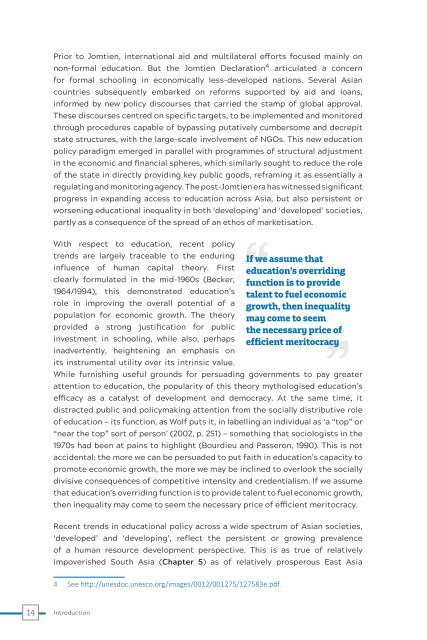Rethinking Schooling for the 21st Century
UNESCO MGIEP officially launched 'Rethinking Schooling for the 21st Century: The State of Education, Peace and Sustainable Development and Global Citizenship' in 2017 at the UNESCO General Conference. This study analyses how far the ideals of SDG 4.7 are embodied in policies and curricula across 22 Asian countries and establishes benchmarks against which future progress can be assessed. It also argues forcefully that we must redefine the purposes of schooling, addressing the fundamental challenges to efforts to promote peace, sustainability and global citizenship through education.
UNESCO MGIEP officially launched 'Rethinking Schooling for the 21st Century: The State of Education, Peace and Sustainable Development and Global Citizenship' in 2017 at the UNESCO General Conference. This study analyses how far the ideals of SDG 4.7 are embodied in policies and curricula across 22 Asian countries and establishes benchmarks against which future progress can be assessed. It also argues forcefully that we must redefine the purposes of schooling, addressing the fundamental challenges to efforts to promote peace, sustainability and global citizenship through education.
Create successful ePaper yourself
Turn your PDF publications into a flip-book with our unique Google optimized e-Paper software.
Prior to Jomtien, international aid and multilateral ef<strong>for</strong>ts focused mainly on<br />
non-<strong>for</strong>mal education. But <strong>the</strong> Jomtien Declaration 4 articulated a concern<br />
<strong>for</strong> <strong>for</strong>mal schooling in economically less-developed nations. Several Asian<br />
countries subsequently embarked on re<strong>for</strong>ms supported by aid and loans,<br />
in<strong>for</strong>med by new policy discourses that carried <strong>the</strong> stamp of global approval.<br />
These discourses centred on specific targets, to be implemented and monitored<br />
through procedures capable of bypassing putatively cumbersome and decrepit<br />
state structures, with <strong>the</strong> large-scale involvement of NGOs. This new education<br />
policy paradigm emerged in parallel with programmes of structural adjustment<br />
in <strong>the</strong> economic and financial spheres, which similarly sought to reduce <strong>the</strong> role<br />
of <strong>the</strong> state in directly providing key public goods, reframing it as essentially a<br />
regulating and monitoring agency. The post-Jomtien era has witnessed significant<br />
progress in expanding access to education across Asia, but also persistent or<br />
worsening educational inequality in both ‘developing’ and ‘developed’ societies,<br />
partly as a consequence of <strong>the</strong> spread of an ethos of marketisation.<br />
With respect to education, recent policy<br />
trends are largely traceable to <strong>the</strong> enduring<br />
influence of human capital <strong>the</strong>ory. First<br />
clearly <strong>for</strong>mulated in <strong>the</strong> mid-1960s (Becker,<br />
1964/1994), this demonstrated education’s<br />
role in improving <strong>the</strong> overall potential of a<br />
population <strong>for</strong> economic growth. The <strong>the</strong>ory<br />
provided a strong justification <strong>for</strong> public<br />
investment in schooling, while also, perhaps<br />
inadvertently, heightening an emphasis on<br />
its instrumental utility over its intrinsic value.<br />
If we assume that<br />
education’s overriding<br />
function is to provide<br />
talent to fuel economic<br />
growth, <strong>the</strong>n inequality<br />
may come to seem<br />
<strong>the</strong> necessary price of<br />
efficient meritocracy<br />
While furnishing useful grounds <strong>for</strong> persuading governments to pay greater<br />
attention to education, <strong>the</strong> popularity of this <strong>the</strong>ory mythologised education’s<br />
efficacy as a catalyst of development and democracy. At <strong>the</strong> same time, it<br />
distracted public and policymaking attention from <strong>the</strong> socially distributive role<br />
of education — its function, as Wolf puts it, in labelling an individual as ‘a “top” or<br />
“near <strong>the</strong> top” sort of person’ (2002, p. 251) — something that sociologists in <strong>the</strong><br />
1970s had been at pains to highlight (Bourdieu and Passeron, 1990). This is not<br />
accidental: <strong>the</strong> more we can be persuaded to put faith in education’s capacity to<br />
promote economic growth, <strong>the</strong> more we may be inclined to overlook <strong>the</strong> socially<br />
divisive consequences of competitive intensity and credentialism. If we assume<br />
that education’s overriding function is to provide talent to fuel economic growth,<br />
<strong>the</strong>n inequality may come to seem <strong>the</strong> necessary price of efficient meritocracy.<br />
Recent trends in educational policy across a wide spectrum of Asian societies,<br />
‘developed’ and ‘developing’, reflect <strong>the</strong> persistent or growing prevalence<br />
of a human resource development perspective. This is as true of relatively<br />
impoverished South Asia (Chapter 5) as of relatively prosperous East Asia<br />
4 See http://unesdoc.unesco.org/images/0012/001275/127583e.pdf.<br />
14<br />
Introduction

















